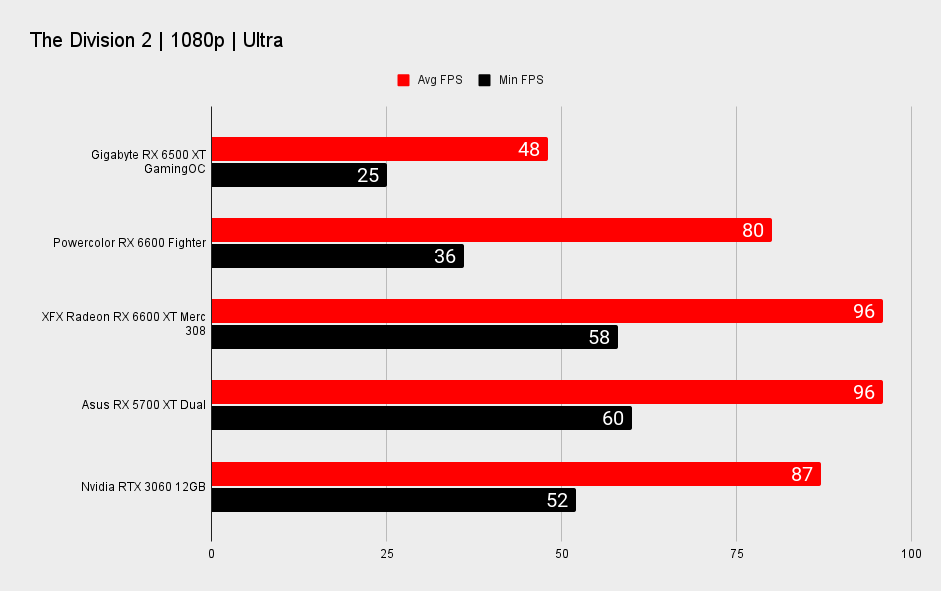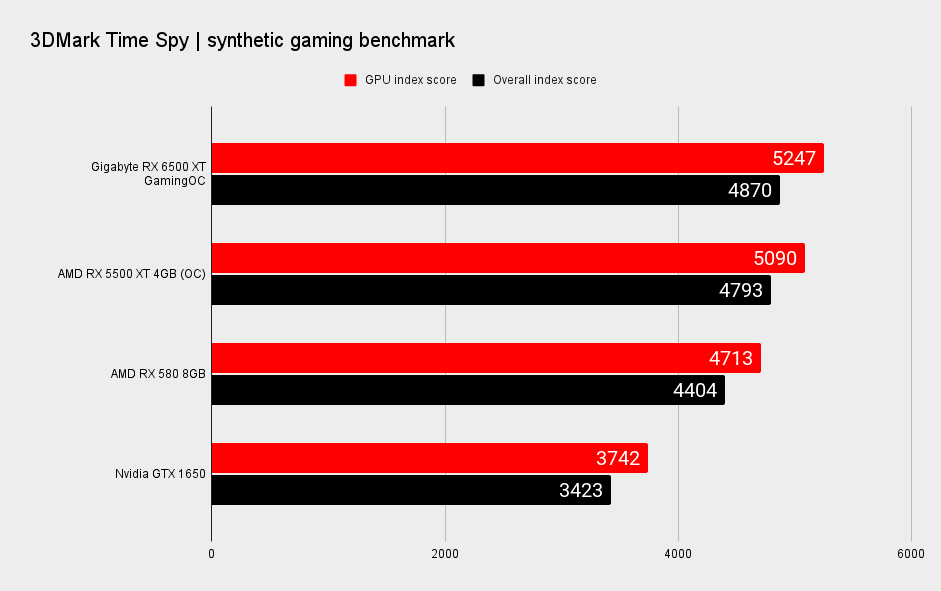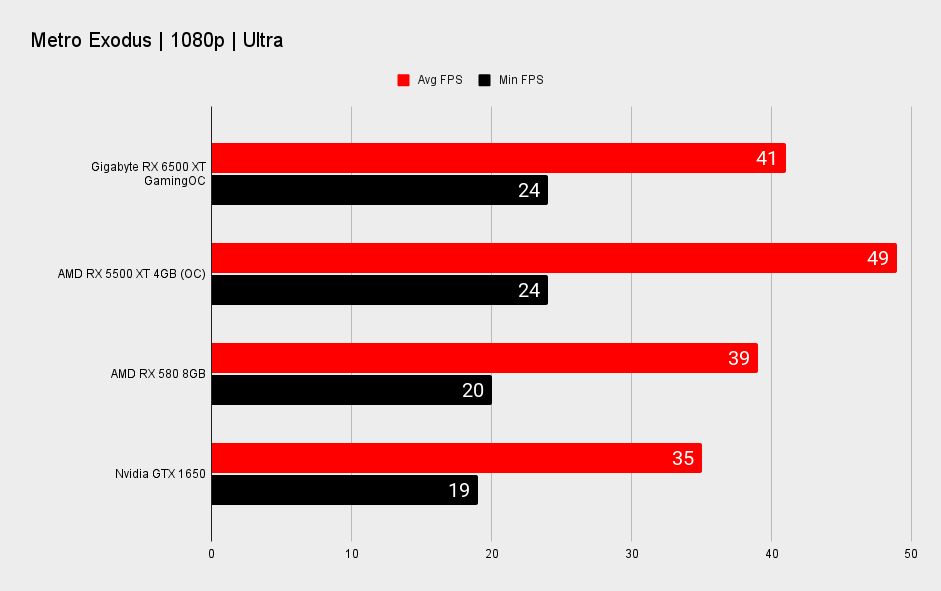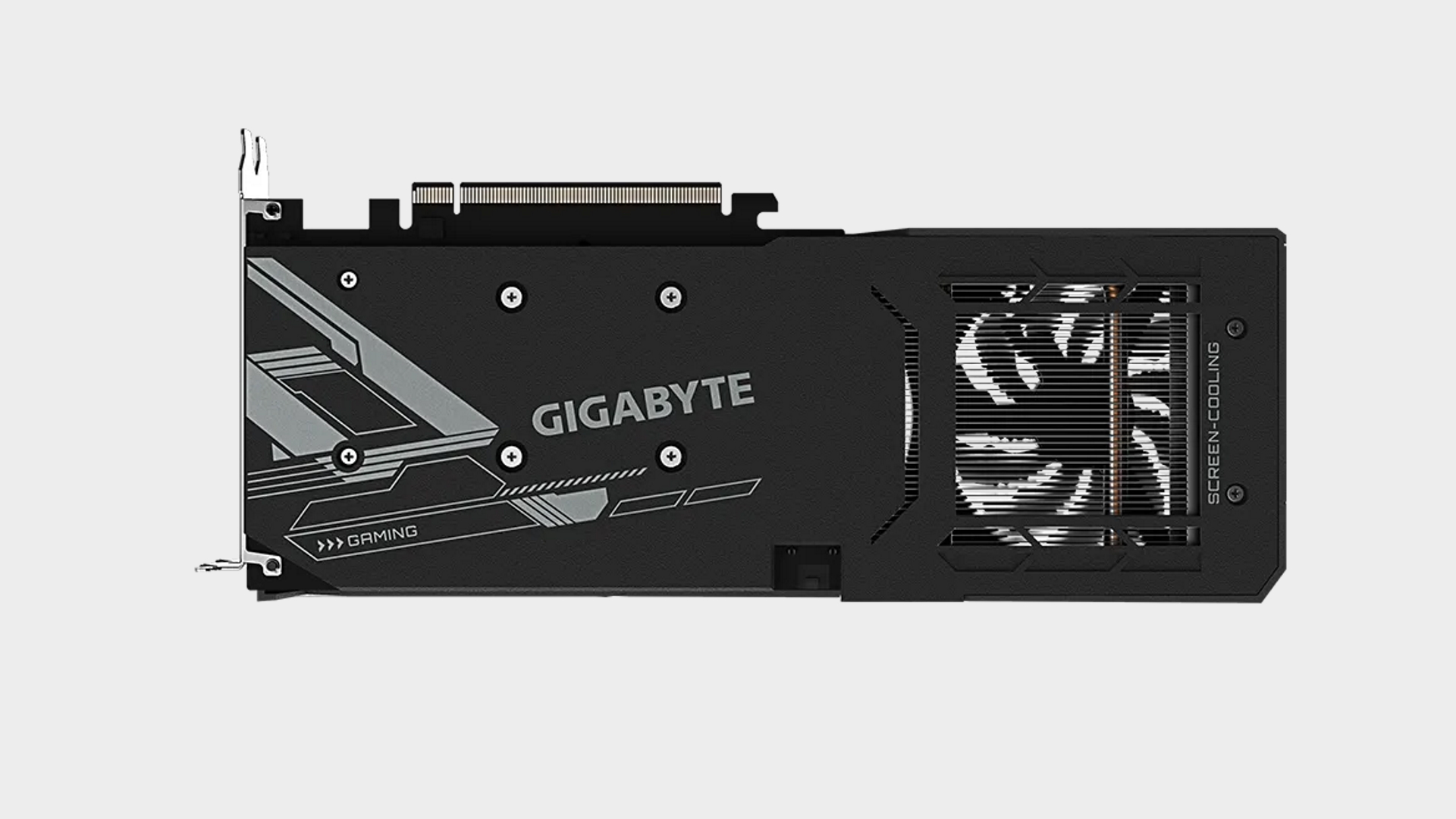Our Verdict
A graphics card built to offer the barest minimum of hardware, fails to move the game on, and feels like the most cynical, GPU-crisis graphics card we've seen yet.
For
- It's in production
Against
- Ephemeral MSRP
- Weak 4GB capacity
- Last-gen gaming performance
PC Gamer's got your back
It's hard not to find the launch of the new AMD Radeon RX 6500 XT a bit depressing. This is a card born of the nightmarish landscape of the current graphics card market, and just highlights the predicament of any PC gamer hoping to upgrade their old GPU at a time where pricing has gotten way out of hand. This is the first budget graphics card of the latest generation from either AMD or Nvidia, and as such a new $199 GPU ought to be cause for celebration, but that price will be ephemeral at best, and as a modern graphics card it looks like pretty weak sauce.
What it is, claims AMD, is an affordable GPU upgrade for the 47% of gamers still using graphics cards that are slower than an RX 570 or GTX 1650. And that's an audience which has been starved of options in this latest generation of GPUs. With ever more high-end cards getting released with ever higher price tags, the budget end of the market has been a barren wilderness, with stock of even the classic older cards having long since dried up in the face of a resurgent crypto mining industry.
RX 6500 XT specifications
What are the RX 6500 XT specs?
The RDNA 2 architecture that resides inside the new 6nm Navi 24 GPU is without doubt a step up in terms of design compared with either the GCN or Turing architectures of those older cards, and has allowed AMD to be rather parsimonious with the silicon that it has dropped into the RX 6500 XT.
The power of AMD's latest Radeon architecture means that it needs just 16 compute units, and therefore only 1,024 stream processors—and a physical GPU footprint that's less than half the size of the 14nm chip nestled in the ol' RX 570—to be able to offer an upgrade over the aging graphics cards of that large percentage of PC gamers.
The Infinity Cache feature of the RDNA 2 design also allows AMD to use a 64-bit memory interface to go along with its 16MB of magic cache memory. That means you get an effective bandwidth of 231.6GB/s from the paltry 4GB of GDDR6 VRAM onboard the RX 6500 XT.
The RX 6500 XT is barely offering anything new, certainly not in terms of raw graphical performance
It also means that, like the rest of its RX 6000-series brethren, this GPU can clock like an absolute beast. The base Game Clock AMD has marketed the RX 6500 XT with is a pretty astounding 2.6GHz; "the fastest clocks on a gaming card," says AMD. That allows the card to offer 5.77 TFLOPS of single precision compute power from a very slight GPU.
Which does, however, all put it significantly behind the nearest GPU in the Radeon RX 6000-series stack, with the next step up, the RX 6600, offering 1,792 RDNA 2 cores, twice the amount of Infinity Cache, memory, and size of aggregated memory bus.

It's also significant that if you look at the last two generations of AMD's sub-$200 4GB graphics cards—the RX 5500 XT and RX 480/580—the RX 6500 XT is barely offering anything new, certainly not in terms of raw graphical performance.
What AMD does point to, though, is that the ecosystem surrounding the RDNA 2 architecture can support the weaker hardware and push it further than either the first-gen RDNA card or the classic GCN GPU. With features such as Smart Access Memory, FidelityFX Super Resolution (FSR), and Radeon Anti-Lag the newer card should have the edge. Though, thanks to AMD's general backwards compatibility benevolence, the Polaris-based cards and first-gen RDNA cards will all play nice with the last two features anyways.
| Header Cell - Column 0 | AMD Radeon RX 6500 XT | AMD Radeon RX 5500 XT | AMD Radeon RX 480 |
|---|---|---|---|
| Release date | January 2022 | December 2019 | June 2016 |
| Shader Cores | 1024 RDNA 2 | 1408 RDNA | 2304 GCN |
| ROPs | 32 | 32 | 32 |
| Texture Units | 64 | 88 | 144 |
| Memory | 4GB GDDR6 | 4GB GDDR6 | 4GB GDDR5 |
| Memory bus | 64-bit | 128-bit | 256-bit |
| Memory bandwidth | 144 GB/s | 224 GB/s | 224 GB/s |
| Processing power | 5.77 TFLOPS | 5.20 TFLOPS | 5.83 TFLOPS |
| Board power | 107W | 130W | 150W |
| Price | $199 | $169 | $199 |
FSR is AMD's open response to Nvidia's Deep Learning Super Sampling (DLSS) feature, though isn't tied to the hardware as the GeForce tech is. It isn't quite as sharp as DLSS, but still offers gamers higher frame rates in compatible games with limited impact on overall fidelity levels, especially in motion. In short, it's pretty damned great, though does need developer implementation to work. But there is Radeon Super Resolution on the way in a forthcoming driver release, which will be a driver level version that ought to work on any game in your library.
Gigahertz do not maketh the GPU
Such neat upscaling tech is great for low-end hardware such as the RX 6500 XT, and ought to give it a bit of a leg up in terms of frame rates going forward, but is a crutch rather than a bonus feature. Radeon Anti-Lag isn't about frame rates, but is aimed at driving down input lag in competitive games, especially those titles which are GPU bound and therefore graphics drivers can have a genuine impact.
Smart Access Memory, however, is limited to the RDNA 1 and 2 architectures, and is the tech which allows AMD CPUs to access all the memory built into an AMD GPU, delivering slight performance gains when you're running an entirely AMD-based gaming rig. Still, slight gains are better than no gains.
The card we're testing here is the Gigabyte RX 6500 XT Gaming OC and is likely representative of the sorts of options you can expect once the initial stock of reference-priced cards inevitably runs dry. That means, while AMD has listed the MSRP of the RX 6500 XT as $199, the Gigabyte version is ~$300.
For that extra money you get a fancy triple-fan cooler, which does an impressive job of keeping things always below 55°C, and whisper quiet. You also get a neat factory overclock which ensures this nominally 2.6GHz Game Clock GPU pretty much constantly runs at over 2.8GHz under load.
That's seriously quick, but gigahertz do not maketh the GPU…
RX 6500 XT performance

How does the RX 6500 XT perform?
We'll spare you death-by-benchmark graph for this one, as we only really need to provide numbers for the 1080p gaming performance of the RX 6500 XT. It can't cope with the top settings at that standard resolution so stepping up to 1440p or, heaven forbid, 4K is too much for the poor Navi 24's 4GB frame buffer.
It's worth checking out the comparative performance between the RX 6500 XT and the last-gen, and last-last-gen sub-$199 graphics cards. There's not a lot in it.
1080p gaming performance









GPU performance benchmarks



Last-gen 1080p gaming performance comparison




RX 6500 XT analysis

How does the RX 6500 XT stack up?
The lower end of AMD's RX 6000-series graphics cards have been GPUs of diminishing returns. Where the RX 6800 XT is one of the best graphics cards we've ever had the pleasure of jamming into the test bench, a GPU that pushed Radeon tech further than ever before, the RX 6600/XT cards from late last year made it look like nothing had changed since the launch of the RX 5700 XT from 2019.
This RX 6500 XT seems worse than that. In all honesty it's hard to look at this as any sort of upgrade from the RX 480 and RX 5500 XT 4GB cards from years ago. Those were both similarly priced from an MSRP point of view, in fact the RX 5500 XT 4GB was a $170 GPU.
And at the time AMD was even recommending gamers look beyond 4GB. How times change…
Sure, compared with an RX 570 or GTX 1650, the RX 6500 XT is a performance upgrade, but only really in the same way an RX 580 was back in the day. The GTX 1650 and RX 570 cards were $150 and $170 cards respectively at launch, so you'd hope all these years later a $199 GPU would offer more performance. And personally I'd be hoping for a lot more performance than this.
I dipped into the performance numbers Jacob and I grabbed from the old RX 5500 XT and RX 580 cards in a previous life and they don't look like great reading. Effectively you're getting RX 580 performance, sometimes lower because of having half the VRAM.
There is a chance, however, that the PCIe 3.0 interface of my MSI Z490 motherboard is holding things back in my testing. Not only is the actual GPU and memory silicon of the RX 6500 XT pared back, the actual PCIe interface is, too. It's running on a x4 PCIe 4.0 interface, which isn't an issue in a modern motherboard with a PCIe 4.0 setup, which has double the bandwidth of PCIe 3.0.
That x4 connection is the equivalent of a x8 PCIe 3.0 slot, which is more than enough bandwidth for 1080p gaming. Cutting that in half, however, might be more of an issue. So, while this might be an affordable upgrade (at MSRP) for a new GPU, it may necessitate a complete PC platform change to get anything like a decent level of performance out of it.
We've carried out a little testing with an Alder Lake platform, with plenty of bandwidth to spare, however, and while there is a performance benefit to the later levels of the PCIe spec, the positive difference is pretty slight.

But this is 2022, and GPU beggars cannot be GPU choosers. There are no mainstream graphics cards left from the old days—even the second hand market has been cleaned out by the miners—and so the mere promise that new $199 cards might actually start to hit the shelves is some sort of bonus for PC gamers desperate for some sort of graphical upgrade for their old system.
That $199 price tag, however, is maybe a bit of a misnomer because beyond the first 15 minutes of availability I would doubt you'll ever see an RX 6500 XT selling for that price once the initial stock sells through. Manufacturers are given rebates to encourage them to sell MSRP versions into retail—and I know on day one there were some available—but retailers would much prefer to have the higher priced editions, such as the overclocked Gigabyte Gaming OC card we've tested here.
After all, if all your GPUs are selling whatever the price, you would rather have stock of pricier cards than the cheaper alternatives. Capitalism is a harsh mistress.
Once the rebates have done their launch job the incentive for manufacturers to make the MSRP versions goes away, and as such I would expect these ~$300 versions of the RX 6500 XT will become the norm if you do manage to catch sight of one in-store, with the $199 pricing but a distant memory.
Then there's the performance. This is a resolutely 1080p card, but even then the 4GB frame buffer makes it a really poor option in 2022. Sure, you can still get decent 1080p gaming performance from dropping the in-game settings—we can't all be playing at Ultra Insane settings in every game—but when you're spending ~$300 on a new graphics card you'd want to feel like you're getting something that could nail 1080p at a decent level.
With modern games, and their high-res textures and broad, open worlds, that 4GB limit comes into play more often than you might think. And when a game has to dip into the slower system memory it doesn't matter that your GPU itself is running at 2.6GHz—or 2.8GHz as this Gigabyte card is regularly doing—your frame rates are going to suffer.
RX 6500 XT verdict

Should you buy an RX 6500 XT?
Noooooooooooooooope. The Radeon RX 6500 XT is a card that would never have existed in this form were it not for the current state of the GPU market. And it's hard to find it anything other than a rather cynically specced chip. It's not possible to otherwise buy any other budget GPU, so there is no incentive to make this latest one any more powerful than the GPUs that it released years ago.
Were things different I would have expected the RDNA 2 generation's $199 card to significantly outperform the equivalently priced versions from the first-gen RDNA architecture and the ancient GCN days.
I'd expect far more silicon in the GPU itself, a larger aggregated memory bus, and more system memory. Make it 8GB of GDDR5 and we'd still be happy, it wouldn't have to be GDDR6 down at this end of the market.
The RX 6500 XT hasn't moved anything along, and that's because it has absolutely no need to. All the cards will be sold to gamers desperate for some sort of GPU upgrade even if miners will steer clear thanks to that weak 4GB memory capacity. It almost doesn't matter what our reaction to the card is, it will likely still sell in volume by virtue of the simple fact it exists. And that anti-mining thing, AMD is calling that a feature. Making it so weak that miners won't buy it is a genuine strategy for getting GPUs into the hands of gamers. It's just that it also makes the RX 6500 XT pretty weak for gaming in 2022 as well.
A graphics card built to offer the barest minimum of hardware, fails to move the game on, and feels like the most cynical, GPU-crisis graphics card we've seen yet.

Dave has been gaming since the days of Zaxxon and Lady Bug on the Colecovision, and code books for the Commodore Vic 20 (Death Race 2000!). He built his first gaming PC at the tender age of 16, and finally finished bug-fixing the Cyrix-based system around a year later. When he dropped it out of the window. He first started writing for Official PlayStation Magazine and Xbox World many decades ago, then moved onto PC Format full-time, then PC Gamer, TechRadar, and T3 among others. Now he's back, writing about the nightmarish graphics card market, CPUs with more cores than sense, gaming laptops hotter than the sun, and SSDs more capacious than a Cybertruck.

